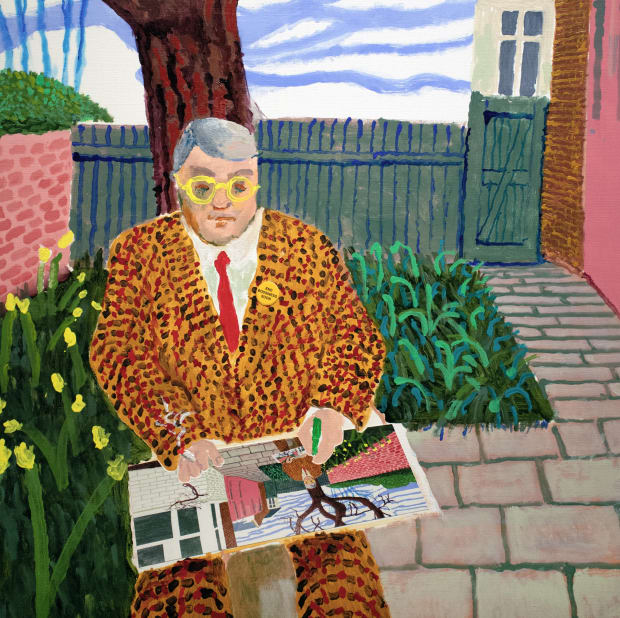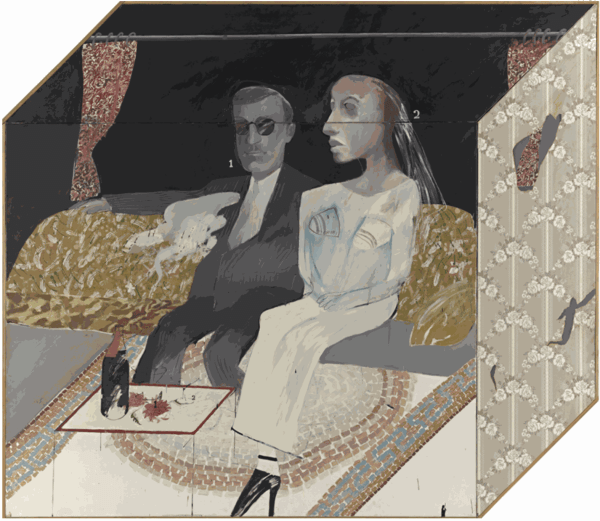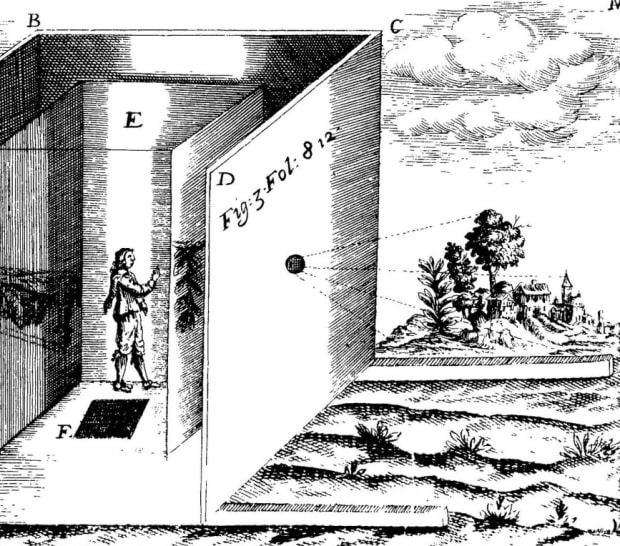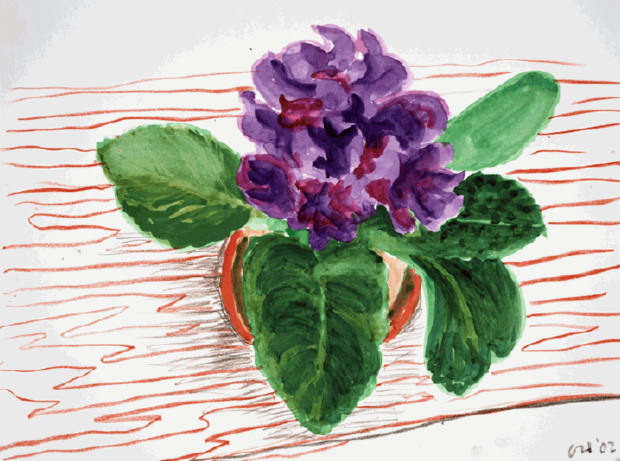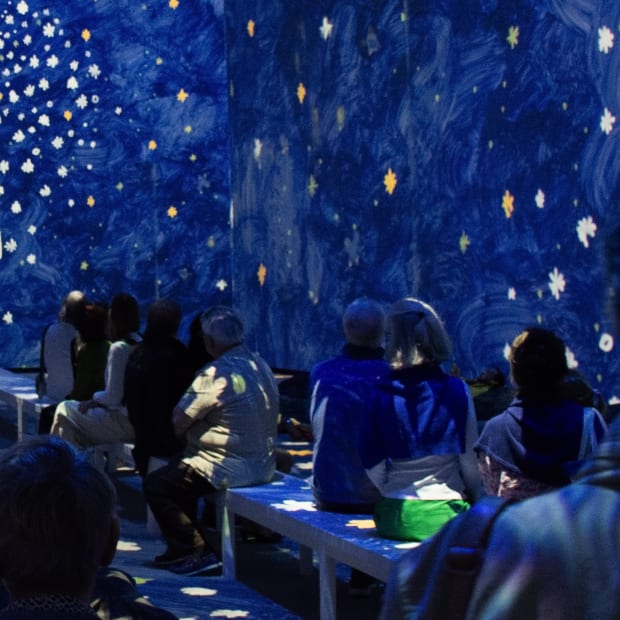-

Close up of David Hockney, Play Within a Play Within a Play and Me with a Cigarette, 2024-25
©David Hockney
-
"Technology has always contributed to art. The brush is a piece of technology, isn't it? But tools don't make pictures. People have to make them."
- David HockneyHockney's highest-selling works of ‘A Bigger Splash, 1967’ and ‘Portrait of an Artist (Pool and Two Figures), 1972’ are some of his most famous, but his more recent artworks have focused on the use of technology, incorporating iPads, computers and immersive, projection rooms. Now his in 80s, he continues to create work pushing artistic material boundaries and furthering his back catalogue of technical experimentation spanning his 60-plus year career. -
Early Career and Artistic Evolution
Hockney began his career in the traditional setting of the Royal College of Art in London. Demonstrating incredible skill, he exhibited in the New Contemporaries exhibition in 1961. However, during this time his nature of pushing boundaries was already evident. At this point, it has become an art world urban legend that in response to the RCA telling Hockney he wouldn’t be able to graduate without submitting a life drawing; he then painted ‘Life Painting for a Diploma, 1962’ in response but refused to submit an essay, wanting to be judged on only his art. This ultimately led to the RCA changing their requirements and he graduated the same year. -

Life Painting for a Diploma, 1964
Oil on canvas with charcoal on paper, collage
70" x 70"
Image Courtesy of The David Hockney Foundation
©David Hockney
-
-

The Second Tea Painting, 1961
Oil on canvas
61" x 36"
Image Courtesy of The David Hockney Foundation
©David Hockney
-

The Second Marriage, 1962
Oil, gouache and collage on canvas
77" x 90"
Image Courtesy of The David Hockney Foundation
©David Hockney
-
-
 Illustration of a portable camera obscura studio, from Athanasius Kircher’s Ars Magna Lucis et Umbrae (1645).Public domain.
Illustration of a portable camera obscura studio, from Athanasius Kircher’s Ars Magna Lucis et Umbrae (1645).Public domain. -

Nathan Swimming Los Angeles 'March 11th 1982', 1982
Composite Polaroid
45.7 x 76.2 cm
©David Hockney
-
Return to Tactile Techniques
In the mid-1990s, David Hockney returned to more tactile art forms, focusing on techniques like etching and painting after years of experimenting with photography and other mediums. One notable series from this period is his dog paintings, created in 1995, depicting his beloved dachshunds, Stanley and Boodgie. These works, characterized by their vibrant primary colors and the serene, sleepy demeanor of the dogs, have become an enduring favourite. The paintings capture intimate, everyday moments with his pets, rendered with a simplicity and warmth that resonates deeply with viewers. These textured, affectionate portraits have been exhibited in major institutions such as The Wallace Collection and Pace Gallery, where they have garnered widespread public admiration. The series not only reflects Hockney’s technical skill but also showcases his ability to evoke emotion through seemingly ordinary subjects, reaffirming his mastery.
-

Looking Down on Purple African Violet, 2002
Watercolour on paper
18" x 24"
Image Courtesy of The David Hockney Foundation
©David Hockney
-
 A Bigger Green Valley , 2008Inkjet printed computer drawing in colours, on two sheets of wove paper, mounted onto two aluminium panels154 x 217 cm©David Hockney
A Bigger Green Valley , 2008Inkjet printed computer drawing in colours, on two sheets of wove paper, mounted onto two aluminium panels154 x 217 cm©David Hockney -
 The Arrival of Spring in Woldgate, East Yorkshire, 11 May, 2011iPad drawing printed on paper55 x 41.5 In©David Hockney
The Arrival of Spring in Woldgate, East Yorkshire, 11 May, 2011iPad drawing printed on paper55 x 41.5 In©David Hockney -
Recent Works and Pushing Digital Boundaries
David Hockney’s recent work continues his tradition of experimentation with artistic technology. In 2018, he created a series of large-scale murals using 3D digital photographs, which were exhibited at prestigious institutions such as the Royal Academy, Pace Gallery, and LACMA. These works represented a new phase in his development with the intersection of traditional and digital media. The murals incorporated various images of his earlier artworks, displayed within a digitally manipulated studio setting.By blending physically made pieces with digital elements, Hockney explored innovative ways to present his art in new contexts. This fusion of past and present techniques not only showcased his adaptability as an artist but also invited viewers to reconsider how art can be experienced in a modern, technology-driven world. The 3D effect of the murals added depth and dimension, immersing the viewer in a reimagined space where the lines between physical and digital art blurred seamlessly. -
 25th June 2022, Looking at the Flowers (Framed), 2022Photographic drawing printed on paper, mounted on Dibond108.5 x 188.5 cm©David Hockney
25th June 2022, Looking at the Flowers (Framed), 2022Photographic drawing printed on paper, mounted on Dibond108.5 x 188.5 cm©David Hockney -
 ©David Hockney ©Fondation Louis Vuitton
©David Hockney ©Fondation Louis Vuitton -
David Hockney's career is a remarkable journey of constant reinvention, marked by his fearless exploration of different mediums and technologies. From his early mastery of painting and sketching to his groundbreaking use of digital tools like Photoshop and iPads, Hockney has consistently pushed the boundaries of artistic expression. His ability to adapt to new techniques while maintaining a distinct personal style has kept his work relevant and influential for over six decades. Whether working with traditional materials or cutting-edge technology, Hockney continues to challenge the art world, proving that innovation and creativity are timeless aspects of his enduring legacy.
-
